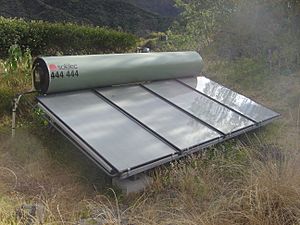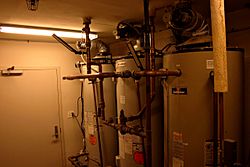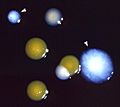Water heating facts for kids
Water heating is a thermodynamic process using an energy source to heat water above its initial temperature. Typical domestic uses of hot water are for cooking, cleaning and bathing, and space heating. In industry both hot water and water heated to steam have many uses.
The most common energy sources for heating water are fossil fuels: natural gas, liquefied petroleum gas, oil or sometimes solid fuels (coal or firewood. These fuels may be consumed directly or by the use of electricity (which may derive from any of the above fuels or from nuclear or renewable sources). Alternative energy such as solar energy, heat pumps, hot water heat recycling, and sometimes geothermal power, may also be used as available, usually in combination with gas, oil or electricity.
Solar water heaters

Solar collectors for solar powered water heaters are installed outside dwellings, typically on the roof or nearby. Nearly all models are the direct-gain type. They consist of flat panels in which water circulates.
Geothermal heating
In countries like Iceland and New Zealand, and other volcanic regions, water heating may be done using geothermal power, rather than combustion.
Images for kids
See also
 In Spanish: Calefacción por agua caliente para niños
In Spanish: Calefacción por agua caliente para niños













